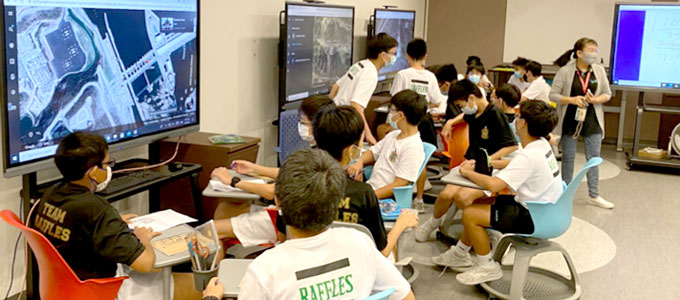
Our Approach
Through an integrative study of physical and human environments, students learn to see events and phenomena through the lenses of space, place, culture and interdependence, and are equipped with the skills to help them negotiate an increasingly globalised and complex world. Students will learn to think critically about issues pertinent to our time, while also understanding and embracing the need for empathy and the adoption of alternative perspectives.
Learner Outcomes
The Geography Raffles Programme syllabus follows the national curriculum, while adding extra breadth and depth in order to further stretch our students in their content knowledge and skills as budding geographers.
In lower secondary, the syllabus explores a range of topics from the key lens of sustainability. From examining the management of our natural resources, to the designing and building of our cities, students are led to consider how we can continue to develop and grow while ensuring sufficient resources for our future generations.
In upper secondary, we move beyond our country’s borders to explore topics ranging across physical and human geography, such as plate tectonics, tourism, and the geography of food. By exploring both the enduring geographical phenomena that have shaped our present as well as contemporary issues that threaten our future, our Rafflesian geographers hone their 21st century competencies, readying them to face a globalised and ever-changing world.
Geography Raffles Academy also engages interested students with the concept-based framework and geographical lens necessary to delve deeper and understand the social, economic and physical forces and processes which shape and change our world today.
Curriculum
Topics that students will learn include:
Year 1-2
- Deforestation - Water Shortage - Population - Housing - Transport | Year 3-4 - Tectonic Hazards - Weather & Climate - Coasts - Tourism - Geography of Food |
Enrichment
Some exciting activities that geography students participated and engaged in include:

1.
URA Field Study Workshop on place making and urban planning. Working with students from other schools, teams proposed suggestions to make Singapore a more liveable city.
2. The
NUS Geography Challenge where the RI team has achieved commendable results. Students spent a few months preparing for the competition.
3. Visit to
Little Guilin, a quarry in Bukit Batok Nature Park, to learn about rock types and erosional processes in tropical environments.
TRY IT OUT! Have a taste of what it’s like to be a junior geographer! Simply
download the PDF and try-it-out!
LOOK IT UP!Feeling bored at home? Why not look up some of these interesting websites to learn more about geography!
3.
Ever wonder how Singapore’s geography has changed over time? Check out these historical maps of Singapore, digitised by NUS’s Department of Geography:
https://libmaps.nus.edu.sg/